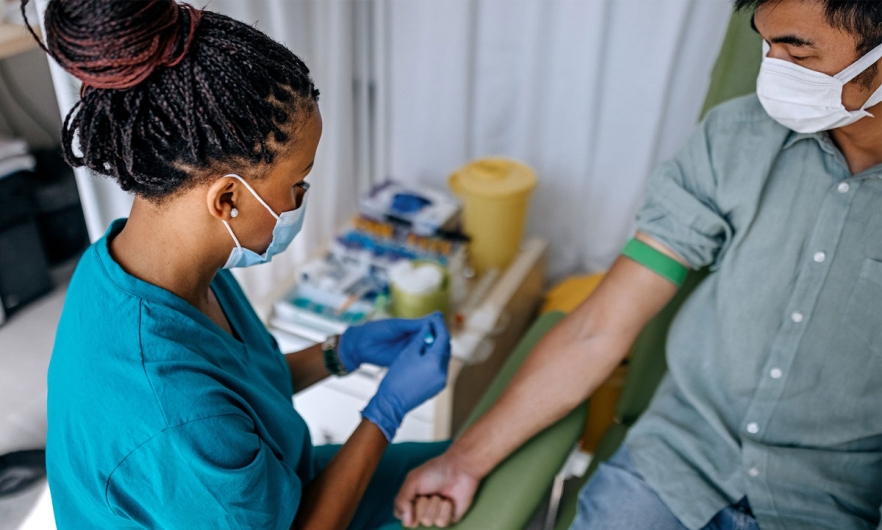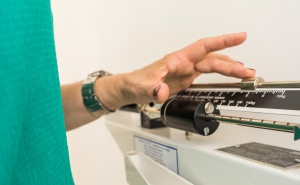Prediabetes Explained: An Under-the-Radar and Common Condition That Doesn’t Have to Lead to a Diabetes Diagnosis

The CDC estimates that more than one-third of Americans have prediabetes, a condition characterized by mildly elevated glucose levels, also known as hyperglycemia. However, most individuals who meet the diagnostic criteria for prediabetes, as many as 90%, are unaware of their condition, which puts them at increased risk of developing type 2 diabetes, heart disease, and stroke.
Why so many people are unaware that they have prediabetes is unclear.
Experts believe it could be due to differing definitions of prediabetes diagnostic criteria and/or the fact that an initial prediabetes diagnosis does not need to be confirmed, while clinical guidelines recommend that an initial diabetes diagnosis be confirmed with a second test.
“I think prediabetes may not be perceived as the most important issue— other health issues may be more pressing,” says Elizabeth Selvin, PhD ’04, MPH, a professor in Epidemiology. “Diabetes is seen as ‘important,’ whereas prediabetes may get overlooked.”
Diagnosis is vitally important, however, as prediabetes is often reversible with modest weight loss. In fact, only 5% to 10% of people diagnosed with prediabetes go on to develop type 2 diabetes.
What is prediabetes?
Prediabetes is a condition which causes a person’s blood sugar level to be elevated, but not high enough to warrant a diagnosis of type 2 diabetes. The American Diabetes Association first introduced the diagnostic criteria for prediabetes (and type 2 diabetes) in 1980 to determine the likelihood of developing bonafide diabetes.
Screening for prediabetes is an important intervention opportunity, says Selvin. It’s a chance to identify people who need to make lifestyle and diet modifications to help prevent the development of diabetes, a condition affecting about 1 in 10 Americans, according to the Centers for Disease Control and Prevention. With increased screening for prediabetes and major improvements in awareness, new research shows the proportion of undiagnosed type 2 diabetes cases declined substantially from 1988 to March 2020.
Type 2 diabetes develops when cells in the body become resistant to the effects of insulin, a hormone made by the pancreas that transforms blood sugar into energy. Over time, the functioning of beta cells in the pancreas may decline, resulting in impaired insulin secretion and high glucose levels. High blood sugar can be devastating to the body, causing a number of health problems including heart disease, kidney disease, and vision loss.
Who’s most at risk?
Middle-age adults who are considered overweight or obese with a body mass index (BMI) of 25 or greater are at the highest risk for prediabetes and later developing type 2 diabetes. Racial and ethnic minorities, as well as people who are either uninsured or underinsured are also at increased risk. Those without health coverage, a group that disproportionately includes socioeconomically disadvantaged men, are less likely to make preventive and/or annual health care appointments, Selvin says, which usually include screening for prediabetes and other conditions through routine blood work and/or exams.
If you develop diabetes in middle age, she says, it can be difficult to lose enough weight to return to normal glucose levels.
The prevalence of prediabetes and type 2 diabetes is also extraordinarily high in older adults. Depending on the diagnosis criteria used, nearly 75% of older adults in the U.S., who often have mildly elevated glucose levels, can be labeled as prediabetic. As we age, our beta cells and our pancreas produce less insulin and use that insulin less effectively, resulting in elevated glucose levels.
Though many older adults meet the criteria for prediabetes, only a small number of those individuals will actually develop diabetes, according to a recent study led by Selvin. Typically, this group is not at high risk for developing complications such as retinopathy, commonly associated with type 2 diabetes. In Selvin’s study, out of 1,490 participants diagnosed with prediabetes, 9% progressed to diabetes, while 13% regressed to normal glucose levels after about six and a half years of follow up. The average age of study participants was 75.
How can I get screened?
Screening for prediabetes can be done as part of routine blood work. A doctor can make a diagnosis with a fasting glucose test, which measures your blood sugar after an overnight fast, or using a non-fasting hemoglobin A1C (HbA1c) test to measure an individual’s blood sugar levels over the past three months.
A fasting glucose test is part of a standard metabolic panel, and is the more common approach to screen for prediabetes. However, since not everyone can fast before getting bloodwork, the A1C test is also routinely used, but is more expensive, Selvin says.
Everyone, especially those considered to be overweight or obese, should be screened for prediabetes. A diagnosis presents an opportunity to make lifestyle modifications to prevent and control other cardiovascular risk factors such as high cholesterol and hypertension.
Differing Diagnostic Criteria
The prediabetic label can come with some confusion, as the diagnostic criteria are not uniform across the globe and exist along a continuum. For example, the American Diabetes Association defines prediabetes as a fasting glucose of 100–125 milligrams per deciliter and/or an A1C of 5.7% to 6.4%. Based on this fasting glucose measure, about 34% of middle-aged U.S. adults meet the prediabetes criteria, Selvin says.
However, the World Health Organization defines prediabetes using a narrower fasting glucose range of 110–125 milligrams per deciliter, resulting in a much smaller group with the diagnosis of prediabetes. WHO does not use the A1C measure to quantify for prediabetes.
“The lack of agreement on a ‘best’ definition for prediabetes causes confusion for both doctors and patients,” Selvin says. “Our work shows that different prediabetes definitions don’t identify the same people and they have different risk implications. So, which should we use? This type of ambiguity can cause delays in diagnosis and prevent people from getting the care they need to prevent diabetes.”
Learn about lifestyle changes the American Diabetes Association recommends that may reverse prediabetes or prevent its progression.
Carly Kempler is the media and audience engagement specialist at the Johns Hopkins Bloomberg School of Public Health.




